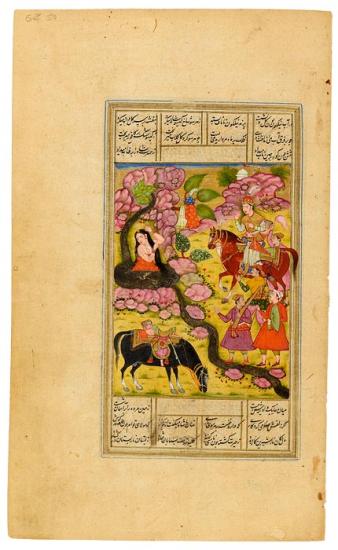
Khusrau Encounters Shīrīn Bathing
Khamsa (Quintet), in Persian, written by Mullā Fatḥ Muḥammad
Purchased by Pierpont Morgan, 1910
Khusrau, in a dream, learns that one day he will wed Shīrīn, an Armenian princess, and own her mother's horse, Shabdīz, the world's fastest steed. He entrusts his friend Shāpūr to arrange her flight to Persia on Shabdīz. Meanwhile Khusrau heads for Armenia and comes upon Shīrīn bathing in a pool. As he nears, his finger raised to his mouth in astonishment, he tells himself he would like to have such a beautiful maiden and horse, little knowing that one day both will be his. As Shīrīn rides away, she wonders if the stranger who startled her might have been Khusrau, though he was not in the anticipated red garb.
This episode appears in Khusrau va Shīrīn (1180) is the second story in Niẓāmī's Khamsa.
Persian poetry
The Persians loved their poetry and their poets, though the Qur˒an warned against believing their words (sura 69.41) and "those straying in evil who follow them" (sura 26.224). While Arabic was the first language of Islam and the language of the Qur˒an, Persian was favored by poets. Even Firdausī's (940–1020) celebrated Shāhnāma (Book of Kings), the national epic of Persian, was written in verse—some 50,000 couplets! Rūmī (1207–1273), the best known of the Sufi poets, put poetry in perspective when he wrote, "A hundred thousand books of poetry existed / Before the word of the illiterate [Prophet] they were put to shame!" (Masnavī I, 529). Presented here are illustrations of Firdausī's Shāhnāma as well as works by Sa˓ dī (ca.1184–1292), Hāfiz (ca. 1320–1389), and Jāmī (1414–1492), regarded as the last of the great Sufi poets. Also featured are illustrations from each of the five poems of the Khamsa (Quintet), by Niẓāmī (ca. 1141–1209), especially Lailā and Majnūn (The Persian Romeo and Juliet) and Bahrām Gūr's Seven Princesses.
